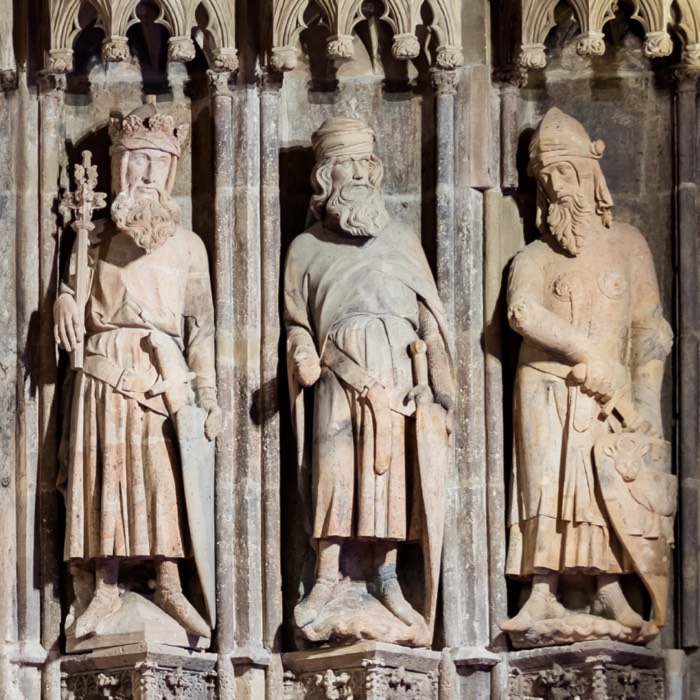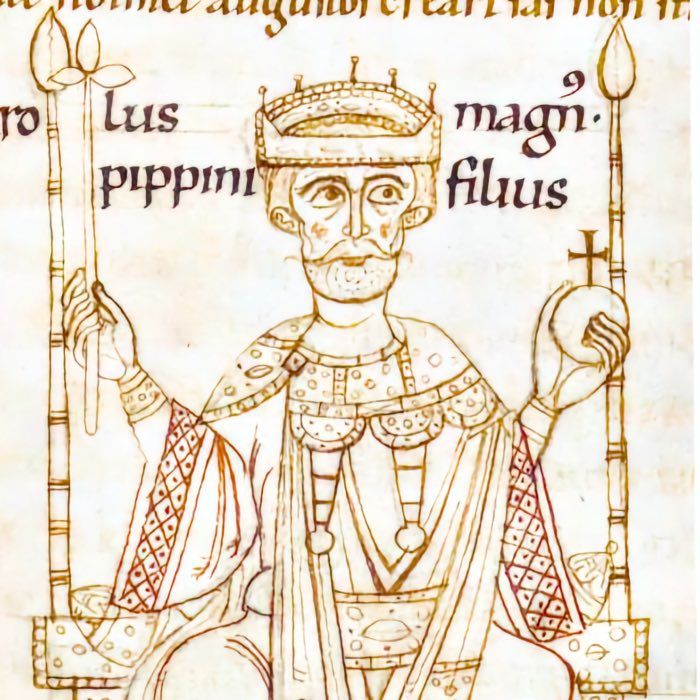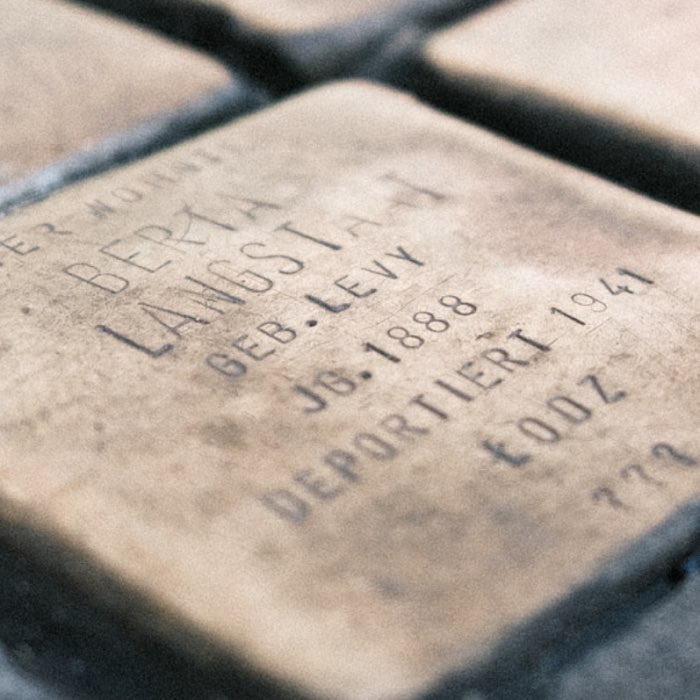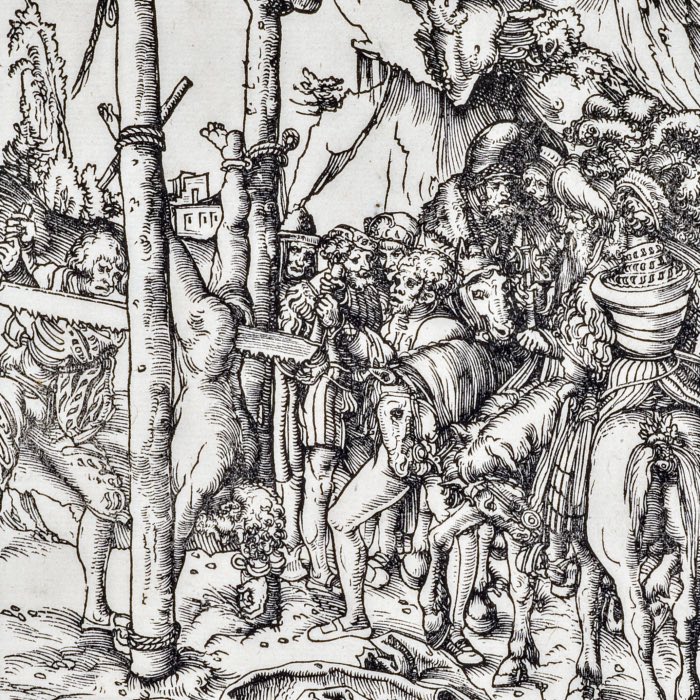1700 years of Jewish history in Cologne
A perhaps not well perceived part of Cologne’s history is its rich Jewish heritage that dates back to the Roman era. The Cologne Jewish community is considered as one of the oldest North of the Alps and has a long and complex history, marked by periods of prosperity and persecution. The community has contributed significantly to the city’s cultural and economic development. Here is a short overview of that history.
 Detail of the “Nine Good Heroes” sculptures from the 14th century on the town hall in Cologne, showing the three Jews David, Joshua, and Judah Maccabee. See description below. Source: Wikimedia Commonsꜛ (license: CC-BY-SA-4.0)
Detail of the “Nine Good Heroes” sculptures from the 14th century on the town hall in Cologne, showing the three Jews David, Joshua, and Judah Maccabee. See description below. Source: Wikimedia Commonsꜛ (license: CC-BY-SA-4.0)
Jewish community in Roman Cologne
Jewish presence in Cologne dates back to the Roman period, making it one of the earliest Jewish communities in Northern Europe. The first documented reference to Jews in Cologne was the decree of 321 issued by Emperor Constantine the Great, which granted the city’s Jewish community access to public office. The document indicates a well-established community in Cologne that actively participated in the city’s cultural, commercial, and religious life.
Jewish life during the Middle Ages
By the High Middle Ages, Cologne had become a significant center of Jewish life, with a thriving community that contributed to the city’s economic and intellectual development. The Jewish quarter, known as the “Judengasse” (lit. “Jewish Lane”), was located near today’s City Hall and was home to a synagogue, a Mikveh (Jewish ritual bath) from the 8th century, and a cemetery. The community was known for its scholarship, and its members were active in various trades, including moneylending, medicine, and the arts.

The Cologne Mikveh from the 8th century (rebuilt in the 11th century), rediscovered in 1956. Source: Wikimedia Commonsꜛ (license: CC-BY-SA-4.0)
 Evidence of Jewish culture in Cologne: The carving of the so-called “Nine Good Heroes” from the 14th century on the town hall in Cologne. The Nine Worthies are nine historical, scriptural, and legendary men of distinction who personify the ideals of chivalry established in the Middle Ages, whose lives were deemed a valuable study for aspirants to chivalric status. The Nine Worthies include (from left to right) three Christians (Charlemagne bearing an eagle upon his shield, King Arthur displaying three crowns, and Godfrey of Bouillon with a dog lying before him), three pagans (Julius Caesar, Hector, and Alexander the Great bearing a griffon upon his shield), and finally three Jews (David holding a sceptre, Joshua, and Judah Maccabee). Source: Wikimedia Commonsꜛ (license: CC-BY-SA-4.0)
Evidence of Jewish culture in Cologne: The carving of the so-called “Nine Good Heroes” from the 14th century on the town hall in Cologne. The Nine Worthies are nine historical, scriptural, and legendary men of distinction who personify the ideals of chivalry established in the Middle Ages, whose lives were deemed a valuable study for aspirants to chivalric status. The Nine Worthies include (from left to right) three Christians (Charlemagne bearing an eagle upon his shield, King Arthur displaying three crowns, and Godfrey of Bouillon with a dog lying before him), three pagans (Julius Caesar, Hector, and Alexander the Great bearing a griffon upon his shield), and finally three Jews (David holding a sceptre, Joshua, and Judah Maccabee). Source: Wikimedia Commonsꜛ (license: CC-BY-SA-4.0)
However, the community also faced periods of violence and persecution. Cologne’s Jews faced hostility, notably during the Crusades and subsequent accusations of well-poisoning during the Black Death. Despite protections like the “Kölner Judenprivileg” (lit.: “Cologne Jewish privilege”), the community often found itself at the mercy of political and clerical powers, culminating in the violent pogrom of the Bartholomäus Night in 1349, falsely accused of causing the plague. Many Jewish residents were murdered, and the survivors were expelled from the city. This event was not isolated, as smaller assaults and discriminations persisted, reflecting a deeply entrenched anti-Jewish sentiment.

Burning of Jews in the Holy Roman Empire (medieval manuscript 1515). Source: Wikimedia Commonsꜛ (license: public domain)
Post-pogrom, Jewish life in Cologne struggled to recover, with sporadic settlements facing constant opposition. The final expulsion in 1424 led many to emigrate, notably to Eastern Europe, influencing the development of Yiddish. A few remained near Cologne, establishing new communities under protective bishops. This period starkly illustrates the precarious existence of Jews in medieval Cologne, marked by brief moments of prosperity overshadowed by pervasive persecution and violence, profoundly impacting the city’s Jewish legacy.
Era of transformation and challenges: 16th to 18th century
From the late Middle Ages to Napoleon’s arrival, Jewish life in Cologne underwent significant transformations, predominantly centered around the burgeoning community in Deutz. Initially modest, this community’s origins trace back to Rabbi Vives in the mid-15th century, serving a small but gradually growing population. By the 18th century, the Deutz Jewish community had expanded to 163 members, forming a distinct quarter around Mindener and Hallenstraße. Here, the first synagogue, mentioned in 1426 and later destroyed by ice drift in 1784, played a central role alongside its associated Mikveh, potentially still existent beneath the Deutzer Brücke’s embankment.
This period saw the Deutz Jewish community navigating within the “Judenordnung” (Jewish Laws) established by the Electorate of Cologne, which dictated their legal and social framework until the introduction of French civil law under Napoleon. The construction of the Hindenburg Bridge necessitated the demolition of their prayer house, replaced by a new building at Reichplatz, which suffered extensive damage during the November Pogrom of 1938 and subsequent war. The community’s last rabbi, Julius Simons, was deported in 1938, with only his son, Ernst Simons, surviving the Holocaust.
The Jewish cemeteries in right-bank Cologne, particularly in Deutz, Mülheim, and Zündorf, offer a poignant glimpse into the community’s history outside the city center. The Deutz cemetery, established in 1695 and closed in 1918, remains a preserved site of memory, marking the resting place of many notable Jewish citizens of Cologne. This era encapsulates a time of both growth and challenge for the Jewish community, navigating the complexities of legal restrictions, societal changes, and the catastrophic impacts of antisemitic violence, leading up to and during the Holocaust.
The Jewish community in the late 18th century to the 19th century
After centuries of prohibition, the French Revolution brought significant changes to Jewish life in Cologne. The occupation by the French Revolutionary Army in 1794 and the introduction of the Code Civil allowed Jews to settle in Cologne once again, marking the beginning of a new era. Josef Isaak from Mülheim was the first Jew permitted to reside in Cologne in 1798, followed by the 17-year-old Salomon Oppenheim Jr. who moved his business from Bonn to Cologne, laying the foundation for the modern Jewish community. Oppenheim’s business acumen led him to run Cologne’s second-largest bank by 1810, and he played a pivotal role both socially and politically within the Jewish community.
A former Clarissan convent in Glockengasse was repurposed as a prayer house by the French occupiers, marking the beginning of organized Jewish worship in modern Cologne. Despite the economic and social rise of Jewish businessmen like Oppenheim, their legal status remained uncertain until the Prussian “Edict”, not universally applied, was superseded by the Prussian Jewish Law of 1847 and the Constitutional Document for the Prussian State in 1848, granting Jews full equality.
The Jewish community experienced growth and structural change, moving away from concentrated quarters to living decentralized among the broader population. This growth led to the establishment of new synagogues, including the Orthodox synagogue in St. Apern-Straße in 1884 and the Liberal synagogue in Roonstraße in 1899, reflecting the diversity within the community. Additionally, initiatives for the establishment of a Jewish state, significantly influenced by the Zionist Association for Germany based in Cologne, marked the community’s political activism, aiming for the foundation of Israel.
The Jewish business sector in Cologne thrived, with notable establishments like Leonhard Tietz’s department store and a strong presence in the banking sector, dominated by Jewish families since the Middle Ages. This period saw the Jewish community contributing significantly to Cologne’s development as a center of science, economy, and culture, with figures like Moses Hess and Karl Marx influencing political discourse through their writings in the Rheinische Zeitung, showcasing the community’s integration and influence in Cologne’s societal fabric.

Synagogue in Glockengasse in the 19th century. Source: Wikimedia Commonsꜛ (license: public domain)
 The Tora (presumably 18th century) of the Synagogue in Deutz, bought by the town in 1926. Source: Wikimedia Commonsꜛ (license: CC-BY-SA-4.0)
The Tora (presumably 18th century) of the Synagogue in Deutz, bought by the town in 1926. Source: Wikimedia Commonsꜛ (license: CC-BY-SA-4.0)
First World War and the Weimar Republic
At the onset of World War I, Jewish organizations in Cologne, along with those across the nation, called upon their members to serve their fatherland with utmost dedication. Despite this patriotic fervor, deep-seated resentments, particularly noticeable within the officer corps, persisted against Jewish servicemen. This led to the infamous “Judenzählung” (Jewish census) conducted by the War Ministry in an attempt to quell such prejudices by ostensibly proving the loyalty and contribution of Jewish soldiers.
With the war’s end in 1918, Adolf Kober assumed the position of community rabbi in one of Germany’s largest Jewish communities in Cologne. Kober played a pivotal role in showcasing Jewish history during the “Millennium Exhibition of the Rhineland” held in 1925 at the Cologne Fairgrounds, highlighting the significant contributions of Jews to the region’s thousand-year history.
Additionally, 1918 marked the opening of the Jewish Cemetery in Bocklemünd, further establishing the Jewish community’s presence and heritage in Cologne during a period of significant socio-political change.
Third Reich and Holocaust
With the Nazi regime’s rise to power, the Jewish community in Cologne faced renewed repression. By spring 1933, Cologne had around 15,000 residents who identified with Judaism. The city had six synagogues and other community houses, all of which were desecrated during the Reichskristallnacht on November 9, 1938, and were destroyed by the end of the war, with the exception of one temple in Roonstraße that could be reconstructed.
Antisemitism was widespread in Cologne, with national socialist attitudes permeating society. Despite post-war claims of resistance spirit attributed to Cologne’s citizens by figures like Konrad Adenauer and Heinrich Böll, actual resistance against the Nazi regime was limited. The antisemitic propaganda infiltrated various levels of society, including performances at the Hänneschen-Theater and the Cologne Carnival, which featured antisemitic motifs and songs mocking Jews.
 Anti-Semitic float from the 1934 Cologne Rose Monday parade. Source: NS Documentation Center Cologne.
Anti-Semitic float from the 1934 Cologne Rose Monday parade. Source: NS Documentation Center Cologne.
The process of “Aryanization” occurred in two phases: voluntary transactions from January 1933 to November 1938 followed by compulsory sales after the Reichskristallnacht, which led to Jewish properties being sold well below value. This affected numerous Jewish businesses and led to their eventual closure or takeover by non-Jewish owners. The antisemitic policies extended to boycotts against Jewish professionals, violent assaults, and the use of Jewish gravestones as construction materials.
The Kristallnacht marked a turning point, leading to the systematic persecution and deportation of Cologne’s Jews. Despite the violent climate, few provided shelter to Jews (e.g., the Ehrenfeld Groupꜛ). The aftermath saw the forced emigration, concentration in “Jew houses”, and eventual deportation to ghettos and extermination camps in Eastern Europe, with only 30 to 40 Jewish individuals in Cologne being liberated by American troops in March 1945.
The El-De Haus, the former Gestapo headquarters in Cologne, houses a permanent exhibition on the history of the persecution, deportation and murder of Cologne’s Jews and other persecuted groups. The exhibition is well designed and offers detailed information about the fate of the Jews. To get an impression of the exhibition, here is a summary of my visit to the documentation center at the beginning of 2024.
 So-called Stolpersteine in Cologne. Stolpersteine are brass plaques embedded in pavements in front of buildings, inscribed with names and dates, memorializing victims of the Nazi regime. Read more about this project in this blog post.
So-called Stolpersteine in Cologne. Stolpersteine are brass plaques embedded in pavements in front of buildings, inscribed with names and dates, memorializing victims of the Nazi regime. Read more about this project in this blog post.
Post-war era and the present
After WWII, Cologne’s Jewish community, which had dwindled from around 19,500 to 11,000 due to the Holocaust, began to rebuild amidst the ruins. Survivors congregated at the relatively intact Ehrenfeld asylum for a new start. By 1949, a temporary synagogue was established on Ottostraße, moving in 1959 to the renovated neoromanesque synagogue on Roonstraße.
This period wasn’t without its challenges. On Christmas Eve 1959, the synagogue and Cologne’s memorial for Nazi regime victims were desecrated by members of the far-right German Reich Party, marked with swastikas and anti-Semitic slogans. Despite these setbacks, the Jewish community persisted in rebuilding and preserving their heritage.
The Jewish Cemetery in Bocklemünd, operational since 1918, continues to serve as a burial site, hosting 58 fragment stones from the 12th to the 15th centuries, relocated from the closed Judenbüchel cemetery in Raderberg. The Jewish Center in Ehrenfeld, succeeding the “Jewish Hospital Ehrenfeld”, became a gathering point for Cologne’s remaining Jews, now functioning as a welfare center with origins dating back to the 19th century.
The modern-day Judengasse, near the town hall, serves as a reminder of the former Jewish quarter, preserving the memory of Cologne’s Jewish heritage and the community’s resilience through centuries of fluctuating fortunes and challenges.
 Today’s Roonstraße Synagogue, in the center of the city. Source: Wikimedia Commonsꜛ (license: CC-BY-SA-4.0)
Today’s Roonstraße Synagogue, in the center of the city. Source: Wikimedia Commonsꜛ (license: CC-BY-SA-4.0)
The future Jewish Museum in Cologne
As part of the Regionale 2010 initiative, the city of Cologne developed an archaeological zone aimed at establishing an archaeological-historical museum complex. This project includes remnants of the Jewish quarter and the Cologne Mikveh located beneath the Rathausplatz, which remained undeveloped post-WWII. The Mikveh, discovered during excavations in the early 1950s, had not been fully excavated until preparations for this new archaeological zone began.
The construction of the Jewish Museum, situated between the historic city hall and the Wallraf-Richartz-Museum, was approved by the city council but faced controversy among politicians and the public over concerns of losing open space in front of the historic city hall. Initially slated to open in 2010, the responsibility for the museum was later transferred to the Landschaftsverband Rheinland (LVR), and it was renamed MiQua. LVR-Jewish Museum in the Archaeological Quarter Cologne (MiQua. LVR-Jüdisches Museum im Archäologischen Quartier Köln). The museum’s completion has been delayed for various reasons and remains unfinished.
 MiQua – LVR-Jüdisches Museum im Archäologischen Quartier Köln (former Archäologische Zone Köln), showing the progress of the excavation in June 2014. Source: Wikimedia Commonsꜛ (license: CC-BY-SA-4.0)
MiQua – LVR-Jüdisches Museum im Archäologischen Quartier Köln (former Archäologische Zone Köln), showing the progress of the excavation in June 2014. Source: Wikimedia Commonsꜛ (license: CC-BY-SA-4.0)
Conclusion
As we look back on the rich and tumultuous history of the Jewish community in Cologne, it’s evident that their story is deeply woven into the city’s history. From its origins in Roman times through the Middle Ages, and into the modern era, the Jewish community has faced adversity, yet it has also contributed significantly to Cologne’s cultural and economic development. The resilience and perseverance of the Jewish people are evident in their ability to rebuild and maintain their identity, even in the face of overwhelming challenges. I think, it is important to recognize and honor the Jewish community’s history and contributions to Cologne, as well as to remember the atrocities they endured during the last 1700 years.
I’m heartened to see that the city of Cologne is taking steps to preserve and commemorate the Jewish community’s history. I’m looking forward to the new Jewish Museum, which will provide a symbol of recognition and remembrance, offering a place to educate future generations about the rich Jewish heritage of Cologne and the importance of tolerance and diversity. Its opening will definitely mark an important moment in acknowledging and celebrating the Jewish community’s integral role in shaping the city’s identity, ensuring that their history is preserved and honored for generations to come.
References and further reading
- Wikipedia article on the Jewish history of Cologneꜛ
- Wikipedia article on the Cologne Mikvehꜛ
- Wikipedia article on the Archaeological Zoneꜛ
- Das Dekret von 321: Köln, der Kaiser und die jüdische Geschichteꜛ, LVR
- Stadtspaziergang zu fünf Orten jüdischen Lebensꜛ, Stadt Köln
- Die älteste jüdische Gemeinde nördlich der Alpen lebtꜛ, Deutschlandfunk
- NS-Dokumentationszentrum der Stadt Köln, Köln im Nationalsozialismus: Ein Kurzführer durch das ELDE Haus (NS-Dokumentation), 2010, Emons Verlag, ISBN: 978-3897052093
- Werner Jung, Bilder einer Stadt im Nationalsozialismus: Köln 1933-1945, 2016, Emons Verlag, ISBN: 9783740800147
- Horst Matzerath, Geschichte der Stadt Köln, Bd. 12: Köln in der Zeit des Nationalsozialismus 1933-1945, 2009, Greven, ISBN: 978-3774304291
- Synagogen-Gemeinde Kölnꜛ
- LVR website on the Jewish Museum in the Archaeological Quarter Cologneꜛ, official MiQua websiteꜛ and MiQua blogꜛ
- Steven Fine, Art and Judaism in the Greco-Roman world - Toward a new Jewish archaeology, 2010, Cambridge University Press, ISBN: 9780521145671

























comments